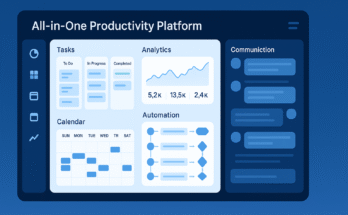There are several steps to build custom project management software applications. Certified project managers regularly use bespoke software products to process and analyze big chunks of data. In most cases, PM software is created as a sophisticated, multi-user platform for recording progress, tracking completed tasks, and monitoring completed projects. As a programmer, you’ll want to discover all the factors, processes, and strategies for building out customized software tools. Read on to learn how to build your own custom project management software.
Design Your Workflow
First off, you need to design a workflow for custom project management software development. In short, your workflow is a process used to hit your most primary development goals. For most custom software development projects, workflows will need to be organized, divided, and segmented into multiple tasks. Typically, these tasks go through multiple stages like planning, designing, releasing, and deploying. Additionally, clearly defined workflows have a straightforward, repetitive process to deliver results. They also clearly divide responsibilities across different software designers, engineers, and quality assurance (QA) experts. Surely, designing your workflow is one of the most important steps to build your own custom project management application.
Outline Your Must-Have Features
Then, outline the must-have features your high quality custom project management application will contain. For a start, your software product needs to support task management, team collaboration and file sharing capabilities. You can also add reporting features and capabilities into your program. Other important features to include are time tracking functionality, which is critical to maintain high productivity, record costs, and forecast time requirements. Certainly, outlining your must-have features is essential to develop a custom project management software.
Configure Your Tech Stack
Now, you are ready to configure your tech stack for custom project management application programming. There’s several powerful tools and technologies you’ll want to use throughout your SDLC. For example, many dev teams use a kubernetes registry by JFrog for secure and private k8s cluster provisioning. This will help you protect code with fine-grained access control throughout end-to-end development. Leveraging these resources, you can utilize a single URL to manage, organize, and control all of your Docker images. Also, they offer universal repositories with unlimited Docker Hub access. This way, you can benefit from powerful functionality to simplify cloud-native application development, while avoiding frustrating image-pull limits. For sure, tech stack configuration is a crucial step to successfully building a custom PM software application.
Select A Development Methodology
Selecting a development methodology is another valuable step to build custom project management software successfully. Software development teams that stick to a proactive strategy are ultimately more successful, productive, and organized. For example, scalable options like the waterfall method focus on record keeping, detailed documentation, and workflow implementation. You also want to choose a methodology that supports task prioritization and rapid deployments. That’s why many software development teams utilize reactive methodologies like agile or lean. Of course, select a development methodology to properly build a custom project management software.
Recruit A Team
Next, recruit an experienced, knowledgeable development team to build your own custom project management software. Every individual on your team needs to be comfortable working on your new software application. In addition, they must be familiar with all of the necessary routine operations of your development process. This will make software design, development, and deployment run much smoother. When recruiting your team, remember it represents the supply chain of your software. Of course, a chain can only be as strong as its weakest link. This means you’ll want to spend extra time recruiting, onboarding, and hiring the right professionals. This way, you can save time and avoid pitfalls down the road. Definitely, recruit a programming team that is comfortable working together to develop a custom project management app.
There are several steps to build your own custom project management software. Companies are increasingly requesting PM software products to improve pipeline forecasting, planning, and optimization. Plus, these tools help improve productivity, efficiency, and profitability. First, design a workflow to organize and prioritize important goals. Next, outline all the must-have features and innovative functionalities your product will contain. Then, configure your tech stack with powerful tools and resources. Many teams work with Docker registries to promote organization, collaboration, efficiency, and security. In addition, select a development methodology to organize the way you will complete activities. Afterwards, you’ll want to build and maintain a high performing team to build your product effectively. Read the steps highlighted above to learn how to build your own custom project management software.




